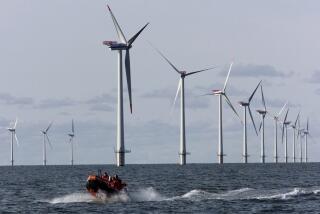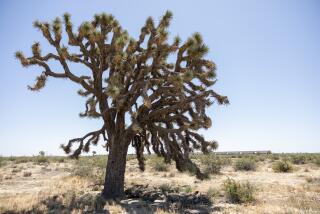Poppy Reserve Neighbors in Huff Over Wind Farm Plan
- Share via
Every spring, the Antelope Valley California Poppy Reserve, 1,800 acres of gentle rolling hills, is transformed into a spectacular gold bloom of flowers swaying in the breeze.
Now, an energy company based in Glasgow, Scotland, wants to harness the power of that breeze in a big way.
The company is talking about building 130 wind turbines taller than the Statue of Liberty in the nearby foothills, 15 miles west of Lancaster.
Representatives from PPM Energy, a subsidiary of Scottish Power, have met informally with local officials and residents over the last year to discuss their plans. The wind farm proposal, however, has met with resistance by some locals, who complain that the massive turbines would obstruct views of the reserve and mar the landscape.
“It would wipe us out in the poppy reserve,” said Milt Stark, president of the Poppy Reserve Mojave Desert Interpretive Assn., which supports educational programs in five desert parks. “It would destroy our view.”
In addition to blocking the scenery, environmentalists are concerned that the hulking turbines would impede the public’s access to the reserve, disrupt migration of wildlife and that the structures’ propeller-like blades would kill birds flying through the remote region.
The debate over providing power for a growing populace versus preserving an ever-shrinking amount of open space is sure to erupt in other California communities as public utilities follow a state mandate that 20% of their power come from renewable technologies by 2017. Other forms of renewable energy include solar and geothermal, as well as small hydroelectric plants.
So far, most energy companies have expressed interest in developing wind, including plans to expand production in the Tehachapi Mountains in eastern Kern County, home of the largest wind energy operation in the state, said Kevin Payne, a spokesman for Southern California Edison.
About 18.2% of the power delivered by Edison last year came from renewable sources, and the utility is moving forward with plans to build 76 miles of new transmission lines across the Antelope and Santa Clarita valleys to carry power generated by wind farms to the California electrical grid.
Current high-voltage transmission lines already are running at capacity, Payne said.
The effort to tap wind energy in the Antelope Valley comes amid something of a boom for wind power across the state.
Environmentalists have hailed the trend, saying wind power is a renewable resource that doesn’t pollute the air or the ocean. They have also argued that wind power can produce energy at competitive prices without harming the environment.
Last year, the High Winds Energy Center, a wind energy generating facility, opened in the hills between San Francisco and Sacramento.
Although officials with PPM Energy in Oregon refused to comment on their plans, saying the details had not been worked out, the company placed two meteorological towers on property near the poppy reserve last year to measure wind speed, a first step in gaining approval from the state Public Utilities Commission to erect windmills.
Residents who met with PPM representatives in the last year said company officials had told them they planned to install 380-foot turbines on at least two sides of the reserve with blinking strobe lights on top as required by the Federal Aviation Administration. In comparison, the Statue of Liberty is 305 feet high.
“They’re monster generators, the size of a 747,” said Mark Butler, a Green Valley machinist. Butler had planned to build his retirement home on 35 acres across the road from the reserve. But he recently postponed his decision after learning about the wind power plan.
“The last place I feel like living is in the middle of a wind farm,” he said.
Each turbine could generate 1.5 megawatts of power on a windy day. A megawatt is enough energy to serve 750 average homes during summer months. But opponents say winds are not strong enough to generate that kind of power most of the time.
During a six-month period in 2003, winds of at least 27 mph -- the amount needed to generate 1.5 megawatts from the turbines -- occurred only 2% of the time, according to calculations done by Friends of the California Poppy Reserve, an organization formed to fight the proposal.
Thirty-six percent of the time, there was not enough wind to generate any electrical power, said Jim Dodson, who conducted the analysis based on data collected from a fire station near the proposed site.
Critics say only one landowner out of dozens in the area has agreed to lease property to PPM, a situation they hope will force the company to retreat or scale back its plan.
Although Butler acknowledges that his beef with the proposal smacks of not-in-my-backyard thinking, he and other critics point out that there are serious environmental concerns as well.
At least four of the parcels owned by the landowner who has agreed to do business with PPM, Healy Farms, fall within a so-called Significant Ecological Area, a county designation intended to protect environmentally sensitive lands.
The designation would add another layer of scrutiny to the permitting process but would not stop it, state officials said.
Dodson said the proposed wind farm would spell doom for the park and surrounding lands, which were primarily used for cattle grazing and growing oats and barley for animal feed.
“Nothing has changed out there in hundreds of years,” Butler said. “And we don’t want anything to change in the next hundred years.”
More to Read
Sign up for Essential California
The most important California stories and recommendations in your inbox every morning.
You may occasionally receive promotional content from the Los Angeles Times.













